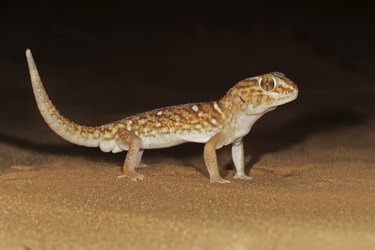thay are just differentiated by lizard species. Most lizards are diurnal, which means they are active during the day and quiet or sleeping at night, just like primates. Because few lizards can regulate their own body temperature, they need sunlight or a heat source to survive. Therefore, being active during the day and quiet at night makes sense. Lizards don't need much food to survive, and most will seek out a place to hide and keep warm during the night.

Video of the Day
However, there are a few exceptions, notably geckos. Not all geckos are nocturnal, but many of these lizards are, and that means they prefer to be active at night and quieter during the day. Nocturnal behavior is an important factor if you are considering geckos as pets or if you are living in or visiting warmer climates where house lizard species, like geckos, might be running wild. Whether lizards are up at night might be a concern in either situation.
Video of the Day
Nocturnal or crepuscular geckos
Several species of geckos that are popular as pets prefer to be more active at night than during the day. For instance, leopard geckos, one of the most common house lizard species, spend most of their days curled up under rocks to avoid predators in the wild, or they stay under twigs and leaves in captive enclosures. For this reason, they are often considered nocturnal.
However, in their natural habitat of northern India, leopard geckos become active at dusk or shortly after sunset to hunt for food, such as invertebrates. Most geckos are insectivorous but will eat fruit as well. Because leopard geckos are usually active from dusk until dawn rather than only at night, some consider leopard geckos to be crepuscular and not true nocturnal creatures.
Staying quiet during full daylight hours makes sense, though, considering the medium-size leopard gecko makes a substantial meal for birds of prey and foxes. In captivity, pet leopard geckos should be fed in the early morning or evening because dusk or twilight is when they will naturally be most active.
Other nocturnal geckos
Other nocturnal geckos include tokay geckos, who are also common as pets. These geckos can reach a length of up to 12 inches, not including their tail. The tokay gecko can regulate body temperature by moving through different habitats in the wild but spend the day hiding under leaves and in the bark of trees. Note that this is a noisy gecko species, most often at night, emitting a bark or "tokay" sound true to the name.
Crested geckos, native to Australia, are also nocturnal and are arboreal, living in trees and high branches. Interestingly, crested geckos were once thought to be extinct, but discoveries in 1994 proved otherwise. Since then, crested geckos are growing in popularity as pets.
Other nocturnal lizard species
The prehensile-tailed skink, also called the monkey skink, are unusual, not only because they use their tail to cling to trees but because they are nocturnal herbivores. During the night, they move through the tree canopy of the Solomon Islands in the South Pacific, eating leaves.
Desert night lizards might count as nocturnal, at least when it's hot. During warmer seasons in the American Southwest, desert night lizards only come out at night, but during cooler temperatures, they become diurnal, hunting insects throughout the day.
Similarly, the misunderstood carnivorous Gila monster is also nocturnal during extremely hot days in the desert but can become diurnal or even crepuscular in different temperatures. Gila monsters are good climbers and are able to forage for eggs in high nests. It's possible to encounter them out and about at any time of day. Sometimes lizards are referred to as lizard breeds but there really aren't breeds; rather, they are differentiated by lizard species.